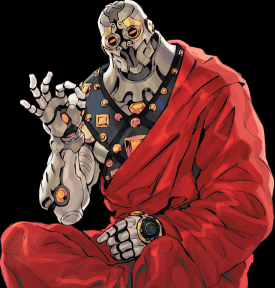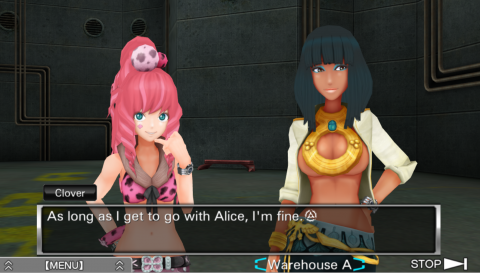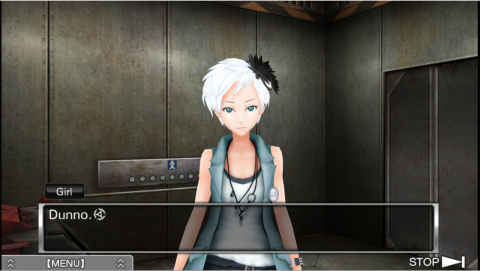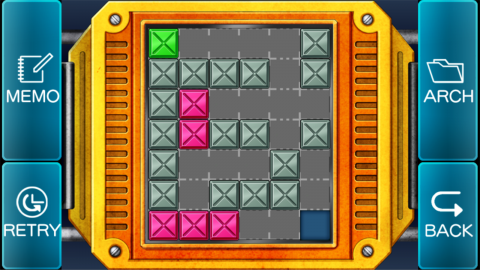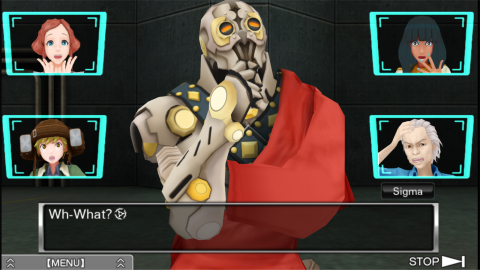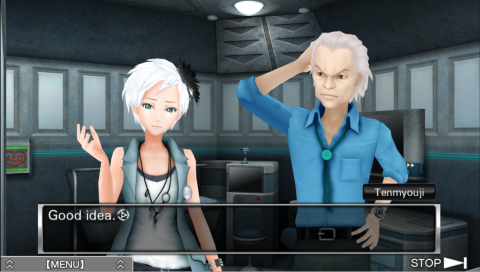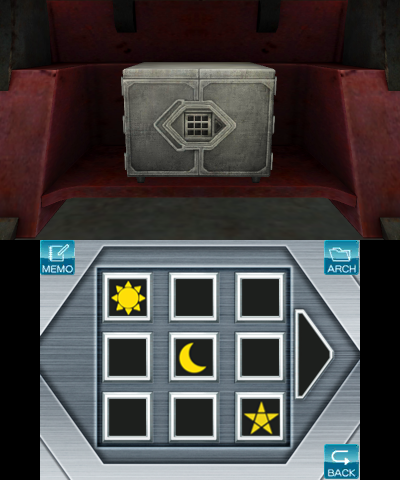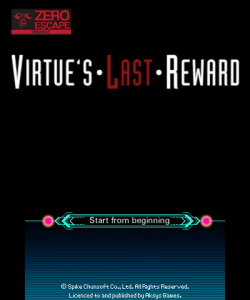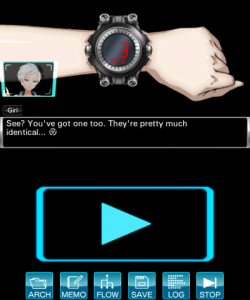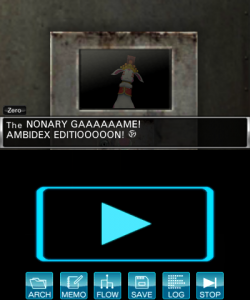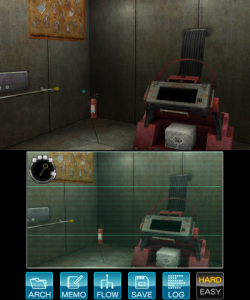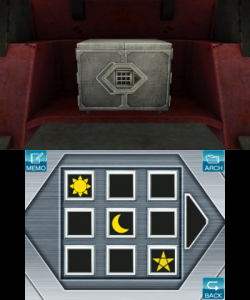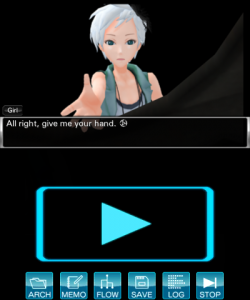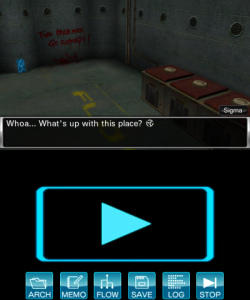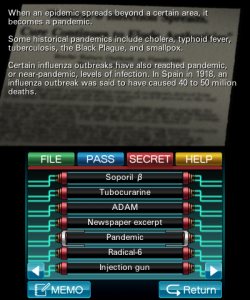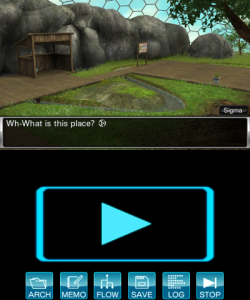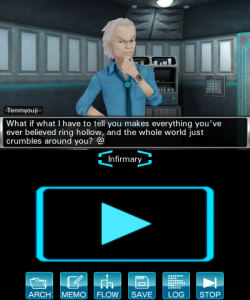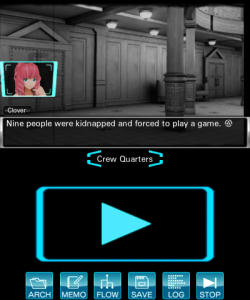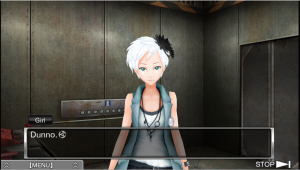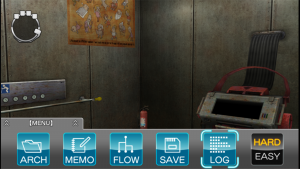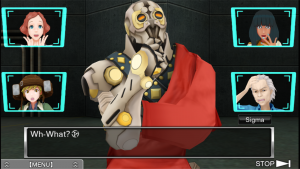- 999: Nine Hours, Nine Persons, Nine Doors
- Virtue’s Last Reward
- Zero Time Dilemma
Virtue’s Last Reward is the sequel of 999: Nine Hours, Nine Persons, Nine Doors. The original game was a visual novel with escape rooms, with a premise rooted in horror (nine people are kidnapped to play a game under the threat of exploding) and had six endings, with many shocking twists to unravel. The game gained a cult following in the US, so much that recent histories identify this game (along with Phoenix Wright and Ghost Trick) as the beginning of the explosion of the popularity of Japanese adventure games and visual novels in the West. Because of this, even though 999 had lost money in Japan, Spike Chunsoft eventually greenlighted a sequel from Kotaro Uchikoshi. However, their market research on 999 identified the horror theme as a turnoff for Japanese audiences, and the decision was made to refocus the sequel into a sci-fi theme.
Virtue’s Last Reward has the same concept of a deadly game, escape rooms, and lots of twists and meta-twists. The game came out for 3DS, PSVita, and later PC (sold as a bundle on Steam with 999). Although not quite as masterful in its execution as 999, it’s an extremely interesting game, very well written, full of great ideas and very cool moments.
Characters
Sigma
The game’s protagonist, a college student. Ostensibly a good guy, generally honest but not very assertive; sometimes inappropriate with women.
Phi
She is direct to the point of abrasiveness, always serious, and extremely smart. Her and Sigma will have a natural, if unusual, bond.
Alice
A very driven woman focused on her own survival; she keeps her cards close to her chest and is a bit of a dark horse.
Luna
This nurse is kindness incarnate, soft-spoken and always striving for peace and cohesion.
Dio
Nobody really likes Dio. He is very confident and outwardly antagonistic, rubbing everyone the wrong way even when he is right.
Quark
A very young boy, very smart for his age, and a never-give-up attitude.
Tenmyouji
A grumpy old man who doesn’t trust anyone and keeps to himself. Has raised Quark all his life.
Clover
Slightly older than in 999, she is the only one that has been in a Nonary Game before. Knows more than she lets on, and does not trust others easily.
K
A man wearing steel armor that cannot be taken off; he has no memory of who he is/was and why he is in the armor. Kind, thoughtful, and cordial nonetheless.
Zero III
Although the real Zero kidnapped everyone and set up the Nonary Game, the players only ever interact with Zero III, an AI appearing as a rabbit with an extremely annoying voice.
This entry ditches 999‘s 2D sprites for 3D character models, animated poses, and speech-synchronized mouths, which really helps make them feel dynamic and alive. (The 3DS’s 3D effect, however, doesn’t really bring anything but make the characters stand out from the background.) In contrast, the CGs that are occasionally shown in important story moments are pre-rendered 3D that unfortunately look a little more mechanical. The real highlight, however, is the dubbing: every single line of dialogue (except the main character’s) is dubbed, with excellent voice acting. Both the English and Japanese dubs can be selected when loading a save, and there is general consensus that both dubs are equally great (which is rare enough to be noted), with Phi and Zero 3 as highlights of the English dub, while Dio is a little more textured in the Japanese dub.
The atmosphere of this game is very different from 999‘s, as highlighted by the very different setting, although some connections with the original game are revealed in the endgame, as one might expect. Gone is the Titanic/Gigantic; here, the nine characters wake up in a warehouse with futuristic doors. The environments are very nicely rendered, with the escape rooms a highlight – they are now full 3D environments, with zooming/dezooming necessary to explore. However, the setting is a bit of a step down compared to 999, as it feels more sterile and less oppressive – the hallways and doors are all interchangeable, all neon and glowing lights in grey/blue corridors and warehouse, and there is lots of back and forth between rooms and floors (illustrated by animations of dots moving on a map). This slows the game’s pace and doesn’t hook the player as much as it should. Additionally, the soundtrack mixes themes from 999 and new themes, but the latter, although perfectly fine, are overall not as evocative as the original ones.
There is significant exposition in the first few hours, as the new Nonary Game is very different from 999‘s – in fact, it seems like a goal for this game was to make it accessible to people who haven’t played the first one, as none of the revelations in 999‘s plot are crucial to Virtue’s Last Reward‘s story. The Nonary Game, explained by a rabbit AI (a comedic highlight), consists in exploring an escape room in groups of three (one Solo and two Pair players, depending on combinations of colors), then voting (Pairs vs Solo) on whether to ally or betray. Depending on the results, points are added or subtracted. Players start with three points, and try to reach nine points, at which point they can open the number 9 door, synonymous with escaping; reaching zero means death. The points matrix is classic prisoners’ dilemma: two parties allying gives the best outcome of two points each, while two “betray”s doesn’t change the points; but betraying an allying opponent gives you three and takes two away from your opponent’s score.
Ostensibly, the game is about trust between strangers – they could all get out if they all allied three times in a row, but do not trust each other to not try to get ahead by betraying each other. There are good reasons for the characters to not ally, ranging from personalities to interpersonal dynamics or the characters’ own histories. Overall, the cast of nine characters is very varied, and most of them are interesting, layered characters which you get to learn more about in various situations. The reasons for their individual votes, and their reactions to others’ votes, are always explored, which allows long-term drama to unfold, including broken trust, refusal to work with each other, along with other shocking elements and potential deaths.
The writing style is more direct than in 999, with fewer descriptions and more economical in words. (This could be a conscious choice of the English translator, who doesn’t seem to be shy about straying away from the original text to go for intent and drama.) All in all the central mechanic leads to a very large number of potential combinations and alliances within the group, and routes of different lengths. However, it is a bit less elegant than 999‘s, as the “random shuffling” of Pair/Solo and color assignments can feel like Uchikoshi putting his thumb on the scale for narrative reasons.
Much like in 999, you are expected to replay the game a few times to uncover all endings if you are to discover all of the narrative’s secrets. Your first playthrough should take 9 – 12 hours, depending on the branch, and there are 22 endings to uncover. However, unlike 999, replaying to a different ending is much easier – the flowchart is more or less displayed from the beginning, and you are free to jump to any previously-unlocked section to change the choices that were made and go down another path. You also get to fast forward previously-seen content, and you don’t need to replay the escape rooms, which was 999‘s major flaw.
This is, however, accomplished at the expense of removing the little side-conversations the characters used to have within the escape rooms, which helped making the characters and the game feel more organic and textured. The escape rooms in Virtue’s Last Reward are similar to the ones in 999, apart from the fact that you can freely rotate the camera within the prerendered 3D scenes. You will need to perform various steps which will end up lighting up a screen with a password for the safe holding the key to the door.
There is a mathematical bent to puzzles, as well as quite a few more original minigames. The rest just involve observing the environment, picking up on clues, and applying the right object at the right place. None of them are fiendishly difficult; furthermore, the game’s default “hard mode” can be toggled to an “easy mode”, which leads to your teammates being much more helpful and giving you clues. For an extra challenge, there is usually a second password to unlock, giving you access to a gold file containing bonus information. However, unlocking these requires quite a bit of lateral thinking (or “read the author’s mind”, some might say), and the gold file it unlocks contains information that often end up being revealed a few minutes later nonetheless, making this an undertaking that’s hard to recommend except for completionists.
To finish the game, you will have to uncover all the content. This means solving all the escape rooms, and exploring the whole narrative branching tree; however, you will find that some branches end prematurely in a cliffhanger, which shows up as a “lock” in the flowchart, that you will need to go back to later, after playing through some other branch. The branching points involve different groups and different ally/betray decisions, meaning the character dynamics are often very different and you end up learning different things in different branches. Lots of twists and unanswered questions also pop up, all of which are integral to the story, and keep things exciting.
However, it can also turn into a bit of a chore around the longer you play, at which point you have seen some events a few times already, but the characters are still withholding information (or, like in 999, “a character is interrupted right before telling you a secret”), and you have to keep solving escape rooms to access the next bit of story that may give you a morsel of useful information. This could vary depending on the orders in which you visit the branches, as some have more exciting events and twists than others. But either way, Virtue’s Last Reward is a sprawling game, and having to explore all of it takes patience. In particular, some of the escape rooms are weaker than others – they are never that big of an intellectual challenge, and some are more fiddly than others, making them feel tedious when all you want is to unlock the next great bit of story.
Virtue’s Last Reward‘s story shines in the last ten hours – at that point, you have a good grip on one of the game’s central conceits and how it informs the shape of the story, which is very smart and still remains unprecedented, and you start having enough information to break some of the “story locks”. This means some pretty big explanations start to arise; however, the game still has a few very big, and very good, swerves up its sleeves, which create some incredible moments. Once again, Uchikoshi shows great flair in controlling exactly which information is revealed at which point, and how to leave a few clues but still throw the player off the scent for maximum impact down the line. All of the mysteries set up in all of the branches get progressively resolved; however, one could say there might be a little too many mysteries for the game’s own good.
Most of the characters have secrets that they are hiding from everyone else, to the point where it all feels unnaturally dense. While 999‘s characters felt like decent humans caught in an awful situations, Virtue’s Last Reward‘s feel like anime characters that exist to reveal information to the player. The game wobbles, but does not fall, in the final moments, as the mysteries threaten to be a little bit too much and create inconsistencies. However, part of it seems to be aimed at creating a cliffhanger ending to set up a third episode (which was hypothetical at the time, contingent on the game’s reception, with the West’s support tipping the scale to make Zero Time Dilemma a reality).
Whether you think it is better than 999 or not, Virtue’s Last Reward is at least definitely in the same ballpark, which is really saying something about its quality. Uchikoshi succeeded once again in creating a deeply layered story full of shocking twists and extremely smart moments, including playing with the story’s format in a way that few games have attempted. The game is overall a smoother experience, and has a great audiovisual presentation, including the excellent dubbing. However, the atmosphere is less vivid, a little more sterile, the characters feel a bit less organic, and the game doesn’t quite succeed in sinking its fangs as deeply or consistently into the player as the previous episode. Some patience might be required before reaching the last third of the game, which is well worth it.
The game first came out on 3DS and Vita, with the only difference being the interface, to accommodate the Vita’s lack of a second screen. (A bug in the 3DS version can randomly corrupt the save file if saving during an escape sequence; the bug is not present in the other versions, however.) The game was then released on PC, along with 999, as the Zero Escape: The Nonary Games bundle, as well as on PS4, and later (in 2022) on the Xbox One. On all of these versions, the interface looks and feels very similar to the Vita version










